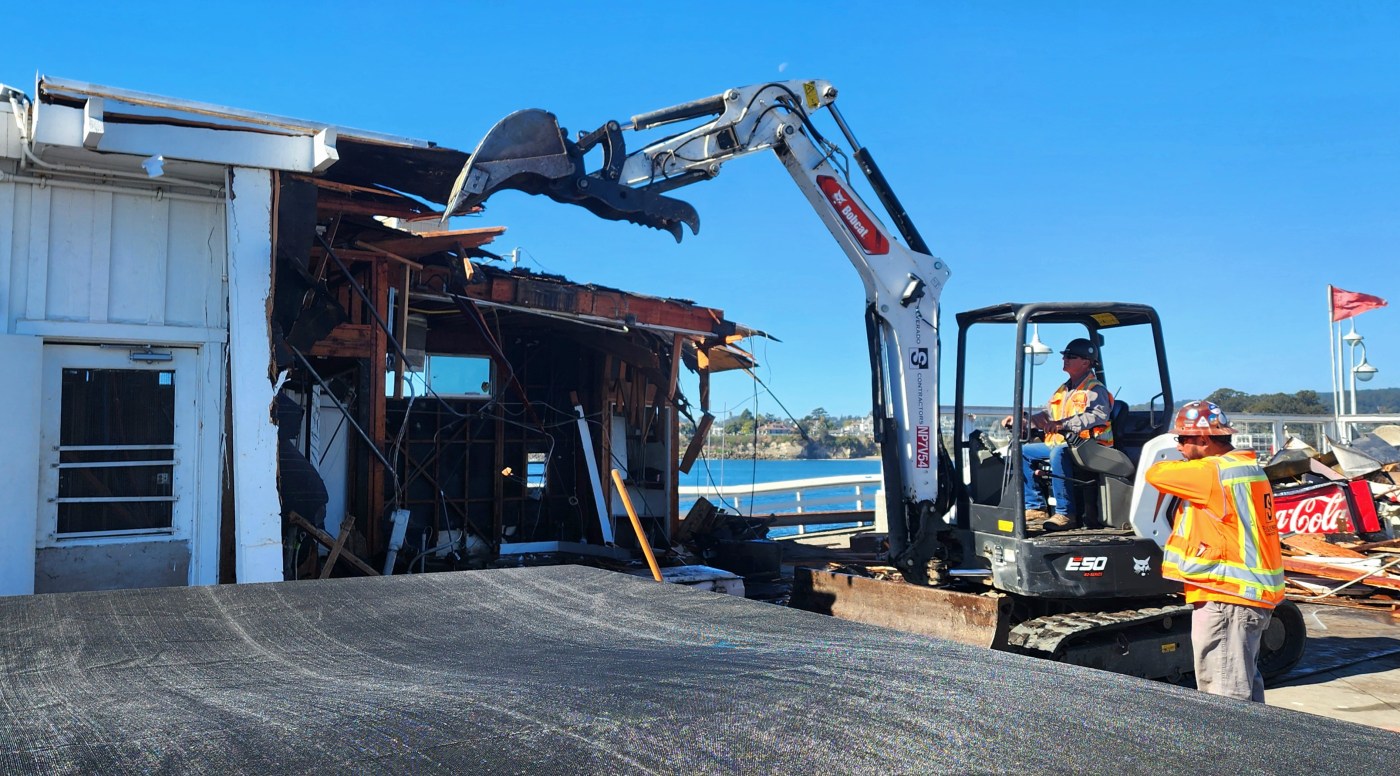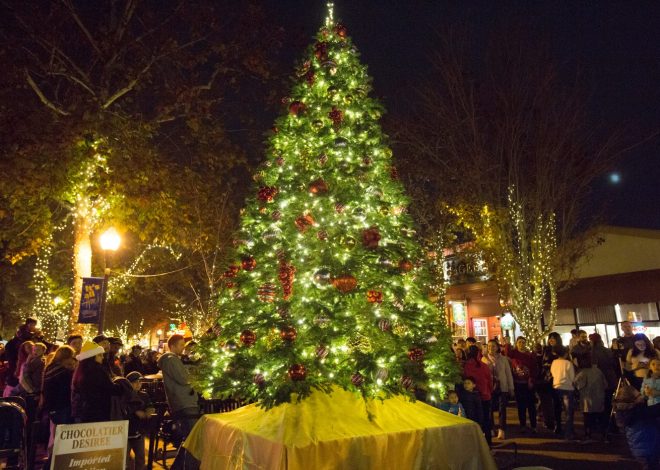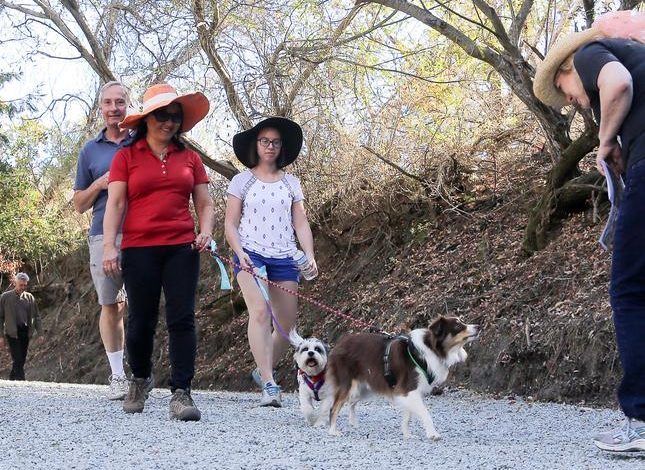
Dolphin Restaurant razed, storm-damaged Santa Cruz Wharf repairs underway
SANTA CRUZ — The Dolphin Restaurant, which has called the Santa Cruz Wharf home for more than 50 years, was demolished bit by bit Wednesday to make room for necessary repairs to the damaged south end of the more than 100-year-old wooden structure.
“The reason that the Dolphin is being demolished is that numerous pilings underneath the restaurant were damaged or went missing during the storms,” said Santa Cruz Development Manager Norm Daly at the site of the demolition. “It’s impossible to replace those piles without the building being removed.”
RELATED: Capitola Wharf ‘grand reopening’ celebrates rebuilding after catastrophic 2023 storm
Daly explained that the city-owned building the Dolphin called home was built in the 1960s and was “functionally obsolete.”
A view from under the west side of the Santa Cruz Wharf where numerous pilings were taken out by wave action during winter storms. (Aric Sleeper/Santa Cruz Sentinel)
“It was really time for something to happen there anyways,” said Daly. “This was a great opportunity to remove that building and then repair the piles underneath.”
Massive waves barraged the coastline in December 2023, causing the city of Santa Cruz to briefly close the entire Santa Cruz Wharf and multiple beaches. Although the wharf reopened later the same day, the viewing holes and Dolphin restaurant at the end of the Wharf were closed until further notice and remain closed due to damage.
With the building removed, the completion of the repairs is now on the horizon and is tentatively slated for March 2025. After the building is razed and the site cleared, construction teams can start replacing approximately 60 pilings.
“The number that we found that were missing or damaged was slightly greater (than 60),” said Daly. “But those piles were adjacent to sound piles and it was determined that they didn’t need to be replaced and the structural integrity of the wharf would still be complete.”
Daly escorted the Sentinel alongside other members of the media behind the fence at the end of the wharf Wednesday to watch the demolition in action, alongside pointing out the damaged and bowed areas on the east and west side of the wharf.
A temporary fix keeps the east end of the Santa Cruz Wharf from sagging further until the pilings can be replaced in the coming months. (Aric Sleeper/Santa Cruz Sentinel)
“This damaged spot is similar to the other side,” Daly said, pointing to the wharf’s east side. “This is a temporary repair to shore up this section of the wharf. Once the pilings are gone, there’s no support under the decking so this metal I-beam is spanning that distance where the piles are missing. And the iron rods that come up from underneath are actually picking up a bent, which is a major piece of the framework. We’re picking the bent up and stopping it from sagging further.”
Daly explained that the wharf, which celebrates its 110th birthday this December, has about 4,400 pilings and 180 bents keeping it above water. Each bent is numbered, he pointed out, with the first bent near the entrance of the structure and the last bent (183) at the end. He mentioned that wharf workers use the assigned bent numbers to communicate locations of issues on and under the structure.
The contractor in charge of driving the new piles into the seafloor is Power Engineering Construction. Grace Bowman, project engineer with the company, explained how construction crews will drive the approximately 60 to 70-foot-long wooden columns into the sea floor.
Because numerous pilings under the Dolphin Restaurant building on the south end of the Santa Cruz Wharf need to be replaced, the more than 60-year-old building was razed Wednesday. (Aric Sleeper/Santa Cruz Sentinel)
“We’ll bring a crane out here and position it in such a way so that it doesn’t fall through the wharf,” said Bowman. “There’s a set of leads and a hammer. You pick the pile up (with the crane), stab it through the hole in the deck where it’s going to go. You get the hammer on, and that’s an impact hammer run by diesel, and it pounds it into the ground.”
Wharf Supervisor Britt Hoberg and Santa Cruz Wharf Recreation Coordinator Annalise Bryant took the Sentinel and other media members under the wharf Wednesday on a small vessel to assess the damage. Bryant explained that she was working on the wharf last winter when the storms destroyed and damaged numerous pilings.
“We were near the edge where the damage happened and talking about the plan to close the end of the wharf when we heard this loud snap,” said Bryant. “Nothing collapsed but it was a sound that I never want to hear again.”
“You hear a lot of sounds out here,” added Hoberg. “But you know when one is really bad.”
When construction is complete next spring, the Dolphin may not be back, but community members can be reassured that the beloved sea lion viewing holes will remain in place. To determine what will populate the south end of the structure after construction is done will be determined through a series of community outreach meetings in the next six to nine months, according to Economic Development Asset Manager David McCormic, who also serves as the lead on the Wharf Master Plan.
“Alongside all of this, in January the Santa Cruz City Council approved the revised Wharf Master Plan, which outlines the future for the wharf,” said McCormic. “There was a concept for a landmark building in the plan and that was removed in favor of a public process to determine what happens next out here.”
McCormic said that the city of Santa Cruz was awarded about $6.9 million by the California Coastal Conservancy in February to be used for projects in the Wharf Master Plan.
“We’ll be finalizing construction plans for a new multi-use pathway along the east side — the east promenade — new overlooks, widening to reinforce the end of the wharf as well as relocating parking booths to reduce traffic and create an entrance.”
McCormic mentioned other projects, including two new boat landings on the structure, one for small vessels and the other for larger vessels such as the O’Neill Sea Odyssey and the Chardonnay charter boats. At the south end of the wharf, McCormic anticipates a commercial component, such as a restaurant along with “recreational and cultural improvements.”
“There might be a visitors center,” said McCormic. “We might look at relocating the Surfing Museum. It’s a process and the community will determine what happens next.”


